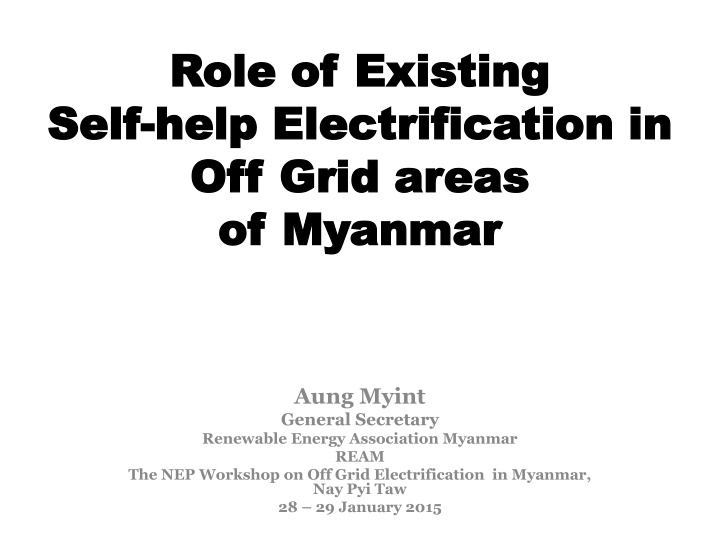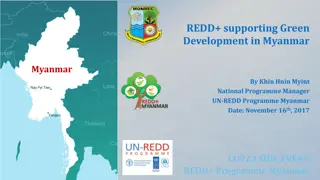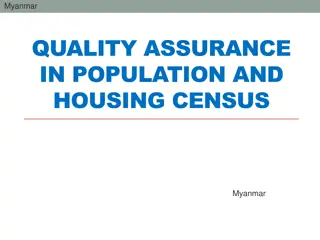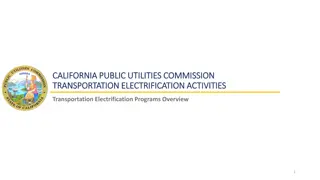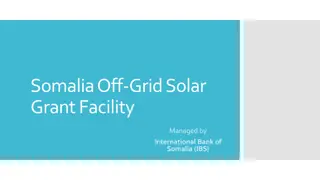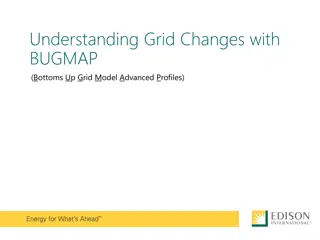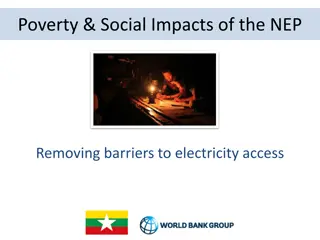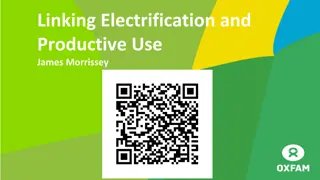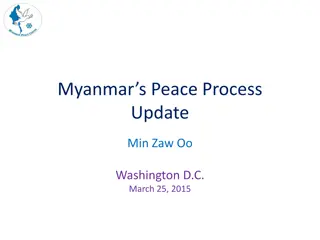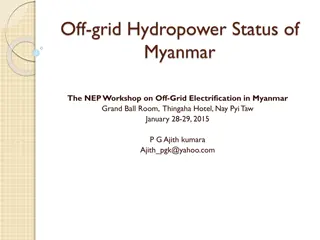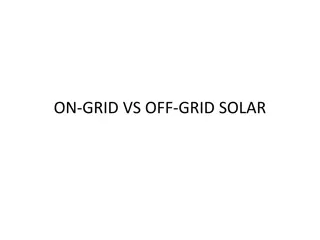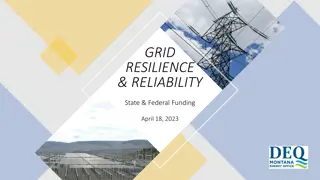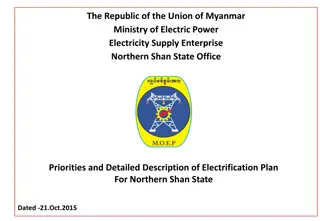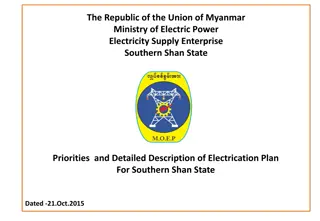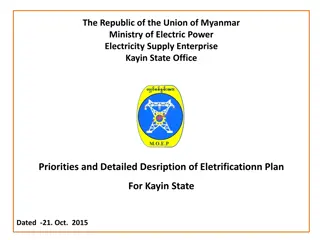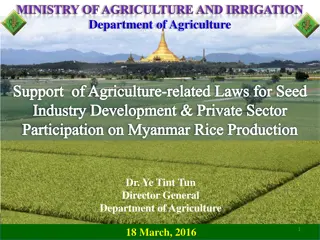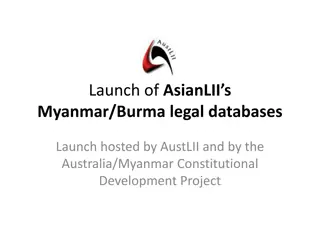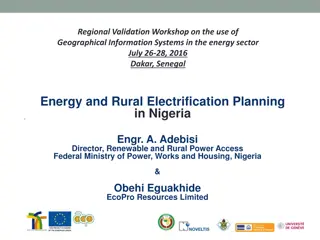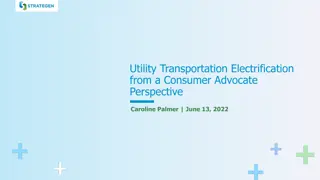Challenges and Solutions for Electrification in Off-Grid Areas of Myanmar
Myanmar is in the midst of a significant policy transformation to enhance development across all sectors, including energy. The country aims to increase electrification from 30% to 100% by 2030, facing challenges due to its vast off-grid areas and economic feasibility issues. Implementing proper plans for on-grid and off-grid electrification is key, building on existing self-help electrification initiatives and leveraging public-private partnerships. The National Energy Plan and initiatives by various committees reflect Myanmar's commitment to improving energy access, despite the complexities posed by its unique topography and infrastructure limitations.
Download Presentation

Please find below an Image/Link to download the presentation.
The content on the website is provided AS IS for your information and personal use only. It may not be sold, licensed, or shared on other websites without obtaining consent from the author.If you encounter any issues during the download, it is possible that the publisher has removed the file from their server.
You are allowed to download the files provided on this website for personal or commercial use, subject to the condition that they are used lawfully. All files are the property of their respective owners.
The content on the website is provided AS IS for your information and personal use only. It may not be sold, licensed, or shared on other websites without obtaining consent from the author.
E N D
Presentation Transcript
Role of Existing Role of Existing Self- -help Electrification in help Electrification in Off Grid areas Off Grid areas of of Myanmar Myanmar Self Aung Myint General Secretary Renewable Energy Association Myanmar REAM The NEP Workshop on Off Grid Electrification in Myanmar, Nay Pyi Taw 28 29 January 2015
POLICY GUIDELINE Myanmar is now at the mid of critical in changing whole country policies to improve and make develop by reforming in every sector of the government including Energy Sector that exist in priority position. National Energy Management committee (NEMC) was formed as a country focal agency for all Energy matters of Myanmar in 2012 to produce Policy guideline. After that, Energy Development Committee (EDP) under the Ministry of Energy and Renewable Energy Work Group (REWG) were formed under the Ministry of Science & Technology (MOST) to produce necessary Laws and Regulations in 2013. A separate department for Energy Efficiency & Conservation (EE&C) was formed under the Ministry of Industry to support country energy sector in 2014.
NATIONAL ENERGY PLAN NATIONAL ENERGY PLAN (NEP) (NEP) National Electrification Committee was formed in 2014 composed of two ministries of the Ministry of Electric Power (MOEP) and Ministry of Livestock, Fishery & Rural Development (MOLF&RD). There is a committee of Rural Water Supply & Electrification at National Ministry level, leading by MOLF&RD. At Present, Myanmar is launching CEP to develop by implementing its electrification ratio 30% to 100% in coming 2030.
POWER TRANSMISSION & POWER TRANSMISSION & DISTRIBUTION DISTRIBUTION Current Country Electrification rate of Myanmar is very low and its OFF GRID area is about 70% of the country. Due to remoteness and uneven topography with many water ways (rivers, creeks), forests and mountains, extension of the present 30% NATIONAL GRID coverage to 100% has many challenges. Another factor of economic feasibility for poor areas with small industries will make face many difficulties in practical implementation of MAIN GRID extension works. PROPER PLAN FOR ON GRID / OFF GRID ELECTRIFICATION ? PROPER PLAN FOR ON GRID / OFF GRID ELECTRIFICATION ?
Existing PPP Attempt on Myanmar Electrification But above two problems has clear answer of PPP attempts in previous decades ago before present National Electrification Plan is launched. It is SELF-HELP ELECTRIFICATION practice of Myanmar. There is a well known term in Myanmar of KO-HTU-KO-HTA MEE-LIN-YAE that popular phrase was widely familiar among not only people, but also in government atmosphere even before the recent Electrification Law with official permission to private sector was launched in late 2014.
Why that hidden capacity and experiences of Myanmar people are not take into account in NEP? It was surprisingly found that such significant situation of real ground practices in entire Myanmar has been neglected when country electrification plan was prepared by the aid of International assistance. Presently launched Country Electrification planning with National Grid extension is focused as main function and for off grid areas, government leading PRE-ELECTRIFICTION function is included to support the newly established Grid extension project. Actually real existing OFF GRID electrification by PPP practices are not under consideration as considerable source of country electrification activities in Myanmar. It is composed of enormous numbers of small sources, but in lump sum, it is large enough to support current SME sector of Myanmar that is about 90% of the country economy. That large measure is not counted as an important factor in current strategic national electrification planning preparation.
BASELINE DATA for Strategic Planning International systematic planning works need concrete baseline data to create a thorough project. It is absolutely correct. Only by that reason, those existing sources of development potential are neglected by doing new idea input of new pre-electrification idea. Currently consideration of international aids should do systematic assessment to get that baseline data as EXISTING ELECTRIFICATION SOURCES to put in main component in present country electrification plan. Improving and upgrading that area of PPP by providing necessary governmental Guidelines, Financing and Technology will be very meaningful than the pre- electrification attempt only by developers ideas.
Strategic Country Electrification approach by International Agencies WB ADB JICA FDI Foreign JV-IPP International Development Organizations
Key Points to Analysis 1. Existing establishments with COST(huge amount in total of capital and operation cost by the PEOPLE) including large numbers of fossil-fuel driving generators and Renewable Energy applications. People capacities at their own ways in many different kinds of self- electrification works of electrification by using various type of Renewable Energies. Myanmar People (upgraded and systematically encouraged Local IPP/SPP/VSPP) has great potential to implement off grid electrification in very short time at the measure of their timely requirement of electric energy. Encourage That GREAT MOMENTUM of the people development by getting chance to development (night light basic need of the remote villages and energy of village cottage industries and SME sector). It won t need MG Watt scale by waiting many years. Speed of People Development Momentum by encouraging their prevailing activities, can be very much practical for future development than waiting years long MG Power supply. 2. 3. 4.
5. Myanmar existing Self-help Electrification practices already has many Renewable Energy application since more than 3 decades ago. 6. Biomass Power is one of the largest country energy sources to utilize in this country energy sector reform phase. Vast amount and renewable biomass sources of forest wastes, agricultural residues and other domestic and industrial wastes can be real renewable energy fuel for the country. 7. Bio-gasified energy systems are very familiar in entire country area. It is a only RE Technology growing commercially country-wide up to this moment. But due to country poverty, lack of government systematic regulatory guidance, proper capital financing and technological improvements, many disadvantages of pollution and low efficiency problems are occurring. It was blamed unreasonably without any proper assessment, improvement and programmatic support.
8. Pico/Micro/Mini/Small Hydro Power in Myanmar is one of the great potential of Renewable Energy explored by PPP at adaptable measure to fulfill their off grid area electrification function up to present moment.
9. Solar Photovoltaic Technology and Solar Thermal Technologies are real baseline resource to solve improvement not only for present, but also for future. country energy
fulfill the GAP in PEOPLES DEVELOPMENT MOMENTUM All those highly potential resources of the country energy sector growing practically at off grid area by clear PPP attempt is the one to include in current Country Energy Electrification Plan at parallel priority with development of National Grid & Large Power Generation function. Upgrading standard of Mini Grid System of Isolated/Interconnected PPP grids can make ready to connect the paralleling developing National Grid. It will be very supportive way of Government and People work to together in NEP implementation. Local People including Public and Private sector can improve their income by Village Cottage Industries level to gradual growth of SME immediately and efficiently at real commercial scale. Not at Government Project oriented scale. It will support the NEP very effectively to cover the whole country electrification 100% in 2030.
REAL REAL POWER DEMAND & SUPPLY at POWER DEMAND & SUPPLY at correct time and space correct time and space ENERGY DEMAND and SYPPLY balancing by avoiding the problems over focusing in country electrification with international loan burden by carefully looking our reality Avoid huge problems of Foreign dependent threat that can happen beyond our control This is real area of Local IPP/ SPP& VSPP to regulate, support and encourage.
Integrated Recourses Planning Approach Existing trend of Peoples Development Momentum should be considered practical initiative source for NEP Country Natural Resources are main driving fuel to be used as Renewable ways Myanmar people will get many jobs along with this systematic upgrading program on EXISTING SELF-HELP-ELECTRIFICATION of Myanmar PPP attempts those are not explore yet. Avoid Natural Disasters and Climate Change impacts by locally control able measure of real Renewable Energy Technology application based on our renewable natural resources. We have to think about Real Energy Security and Sustainable Development for the benefit of the majority people (E4ALL) Work for Value not for COST
Importance of ON GRID / OFF GRID parallel consideration toward NEP Goal To extend the National Grid together with enough huge power generation-plants important. It must materialize in this recent country electricity development action-plan. It is in top priority position to improve country development. In the mean time, to promote, encourage and support the existing SELF-HELP ELECTRIFICATION by fully participation of Private / Public sector is also parallelly important as a priority area to improve and make develop the country electrification at proper timing of short, medium and long term. is extremely
GREAT THANKS TO ALL REAM am.ream@gmail.com
